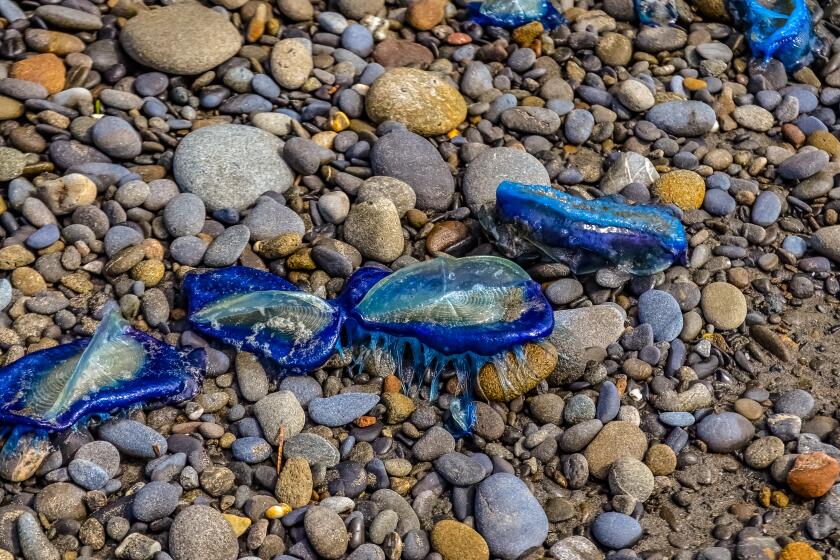HIV, Ebola, SARS and now COVID-19: Why some scientists fear deadly outbreaks are on the rise

Scientists say more than half of newly emerging infectious diseases start in wild animals
The social upheaval and death caused by the new coronavirus has awoken many to what some infectious-disease experts have been warning for more than a decade: Outbreaks of dangerous new diseases with the potential to become pandemics have been on the rise — from HIV to swine flu to SARS to Ebola.
Many experts now believe that this surge in new infectious diseases is being driven in part by some of humanity’s most environmentally destructive practices, such as deforestation and poaching, leading to increased contact between highly mobile, urbanized human populations and wild animals.
“The evidence is clear; we’re driving disease emergence through less sustainable use of nature,” said Dr. Aaron Bernstein, interim director of the Center for Climate Health and the Global Environment at the Harvard School of Public Health.
“It’s happening more often, and it’s mostly happening because of spillover of pathogens from animals to people,” he added.
The number of emerging infectious-disease events in the 1990s was more than triple what it was in the 1940s, according to a prominent study out of University College London that looked at 335 cases over more than half a century.
The report, “Global trends in emerging infectious diseases,” found that about 60 percent of these emerging disease events could be traced back to wild animals, and to a lesser degree, pets and livestock.
The death tolls from these diseases has been relatively small, compared to historical pandemics. However, with each new outbreak comes the opportunity for a disease to escape containment and become a pandemic like COVID-19.
Scientists believe it’s most likely that the new coronavirus, now in more than 70 countries, originated in bats. Researchers are scrambling to pinpoint the specific path of transmission, focusing initial inquires on Chinese markets that butcher and sell exotic animals. It’s not clear whether the virus jumped to another species before infecting humans.
“We’ve picked up many diseases from livestock over the past 10,000 years, but it’s in the last 50 years or so that exposure to exotic species have given opportunities for one-off transfers to humans of things we’ve never seen before,” said Robin Weiss, professor of viral oncology at University College London.
The new battlefront
Many health experts believed that humanity had essentially conquered the pandemic by the mid-20th century, largely thanks to increased sanitation, vaccines and coordinated government efforts to control outbreaks. The official eradication of smallpox in 1979 is often cited as history’s greatest advancement in global public health.
However, despite these medical advances, viruses can now spread at unprecedented speed, thanks to growing access to car and plane travel. And these maladies can find fertile ground to proliferate in bulging megacities, from the epicenter of the new coronavirus — Wuhan, China — to Rome to Madrid to New York.
The issue is compounded, according to experts, as animal habitats are mowed down for agriculture and mining, forcing species to crowd into ever-smaller swaths of jungle. At the same time, global warming has prompted animals to start migrating away from the equator, bringing disease vectors such as rodents, ticks and mosquitoes to previously un-impacted human populations.
As a result, potentially virus-carrying animal species have been increasingly crammed into close proximity with humans — some of whom have exacerbated the situation by hunting wild animals for sale in markets and even expensive restaurants.
“China has an enormous legal and illegal wildlife trade where people go into forests, harvest wildlife, bring them into markets in a helter-skelter, hodgepodge way, and that’s just a set up for disease emergence, and that’s exactly what we’ve seen,” said Harvard’s Bernstein.
In other cases, he added, industrial overfishing has led rural coastal communities to more aggressively harvest potentially virus-laden animals in jungle interiors.
“We have evidence that people who have had their fish stocks depleted, through industrial fishing of the oceans, they are being exposed to retroviruses like HIV on an ongoing basis as they eat bush meat,” he said.
Zoonotic diseases
Some experts believe that today roughly 75 percent of emerging infectious diseases can be traced back specifically to wild animals. That’s the position of the EcoHealth Alliance, a New York-based nonprofit that tracks hotspots for such diseases around the globe.
The group was part of the efforts that tracked the sources of Ebola, SARS and now possibly the new coronavirus back to a bats.
So-called zoonotic diseases are not new. In fact, they’re responsible for some of history’s biggest killers.

The Black Death, or the Great Plague, which took about 50 million people from 1347 to 1351, was spread by fleas carried by rats.
Unlike viral diseases, plague is a bacterial infection, which can kill frighteningly fast. However, that also means that proper sanitation and hygiene can go a long way toward curbing infections.
The 1918 Flu, which killed roughly 50 million people in about two years, is believed to have come from birds and was perhaps transferred to horses in the trenches of World War I before spreading to humans.
The lingering specter of the 1918 Flu, along with more recent bouts of avian flu, had led many experts to fear another deadly strain of influenza could emerge as the next pandemic.
For example, the Asian Flu and the Hong Kong Flu of the 1950s and 1970s killed 2 million people, while the more recent bird flu has ravaged poultry stocks and also cut down humans.
Of course, the most deadly pandemic in recent history has been HIV, which killed about 35 million people since the disease was first identified in 1981. The disease is thought to have been acquired by people hunting chimpanzees in Cameroon and then selling the meat in Kinshasa, the capital of the Democratic Republic of the Congo.
In fact, the practices of poaching apes for food continues to this day, said Dr. Beatrice Hahn, professor of medicine at the University of Pennsylvania and one of the world’s top experts on HIV in chimpanzees.
“They recently closed down a five-star restaurant in Kinshasa because on their menu was smoked baby chimp,” she said.
Hahn believes that efforts to ensure global public health would benefit from more research into the types of viruses currently being harbored in specific animal species.
“What we should do is to look at the natural reservoirs to see what’s out there,” she said. “Let’s not make assumptions but trace it back like a detective. That’s what we did with HIV.”
That’s the type of investigative work that some experts say should be focused on bat populations. The creatures have adapted hardy immune systems to viruses that can have devastating consequences if transferred to humans.
SARS, or Severe Acute Respiratory Syndrome, which killed at least 770 globally around 2003, mostly in southern China, Vietnam and Singapore, is believed to have come from a bat.
Scientists think MERS, or Middle East Respiratory Syndrome, which has killed 850 since 2012, mostly in Saudi Arabia, hopped over to humans from camels first infected by bats.
Ebolavirus, which killed some 11,000 people in West Africa between 2014 and 2016, is believed to have come from people eating bush meat such as monkeys and bats.
Of course, there are other lesser-known zoonotic diseases that haven’t caused as many deaths. Nipah virus, which can also be traced back to bats, can kill a handful of people in India every year.
“Very occasionally, as has happened with COVID, one takes off,” said Weiss of University College London.
“One of the lessons is to expect the unexpected,” he added. “You don’t know which corner or what angle it’s going to come from.”
*Correction: A previous version of this story misstated the number of deaths attributable to the Great Plague in the 14th century.
Get Essential San Diego, weekday mornings
Get top headlines from the Union-Tribune in your inbox weekday mornings, including top news, local, sports, business, entertainment and opinion.
You may occasionally receive promotional content from the San Diego Union-Tribune.











